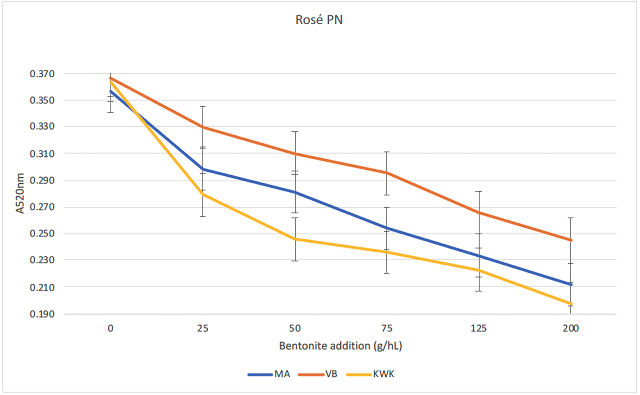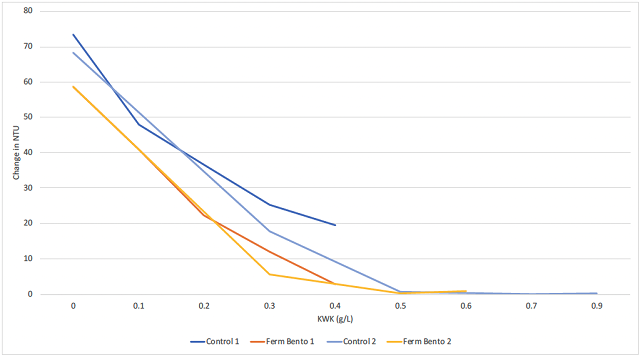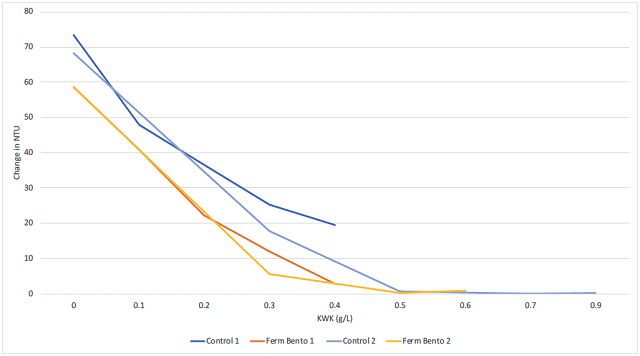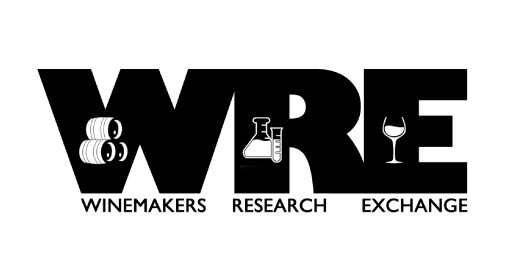Does early bentonite addition improve color in Rosé? (2022)
Melanie Natoli
Cana Vineyards
Summary
Color is important in Rosé. Unfortunately, it is also unstable. Many winemaking operations lead to the loss of color intensity and shifting of color hue. Protein stabilization by bentonite fining can lead to binding of anthocyanins and loss of color very close to bottling. One way to limit color loss close to bottling may be to stabilize protein with bentonite during fermentation. The purpose of this experiment was to test if bentonite use during barrel fermentation of Cabernet Franc Rosé reduced overall bentonite addition rate, preserved aromatics, or improved color retention. Cabernet Franc Rosé fermented with 24 g/hL bentonite showed no difference in color intensity, hue, or concentration of unstable proteins compared to controls. Despite early bentonite addition, both control and treatment wines required 50 g/hL additional bentonite addition to be stable prior to bottling. Unfortunately, there is no means to consistently determine how much bentonite needs to be added pre-fermentation, and steep slopes in binding curves mean that a small change in bentonite rate can result in a big change in protein stability.
Introduction
Worldwide Rosé consumption grew 31% between 2002 and 2016,1 with Rosé often serving as an entry wine for new wine consumers. Rosé can be found in many styles, including wines characterized as fresh and fruity, floral, rich & barrel fermented, and austere thiol driven expresssions.2 The wine style can be influenced by the source variety, processing considerations (like maceration times and yeasts choice) as well as fermentation temperature and vessel type.2] But the most notable descriptor for most Rosé is the color.
Several studies have found that consumer preference and perception of the wine is influenced by color. In a study in 1970, Andre et al (summarized by Jackson) found that, in Rosé, consumer preferences matched their ranking by color when color was visible. However, preferences were in the opposite order when consumers were asked to rank wines without seeing the color. In another study, Morrot et al (2001)(also summarized by Jackson) found that white wines were described with terms used for red wines when anthocyanins were added to give color. This despite findings by Vidal et al (2004) that anthocyanins themselves did not have any impact on flavor.3
Unfortunately, color in Rosé is very unstable, shifting over time based on many aspects of winemaking. The overall amount of color a winemaker has to work with is governed by the source grape variety, the extractability of color in a given vintage, the overall ripeness of the fruit, and the pressing pressure.1 Once anthocyanins have been extracted, color can be retained or lost depending on the redox state (oxidation leads to bleaching and browning), pH (lower pH leads to more color intensity), presence of stabilizing tannins, adsorption onto particles, and SO2 (which leads to temporary bleaching).1–3 Even if color has been well protected during fermentation and aging, further loss may occur during protein stabilization with bentonite.
Bentonite fining for protein stabilization relies on the attraction of positively charged proteins to negatively charged bentonite particles, that then settle out of the wine and are removed by racking. Unfortunately, this mechanism is nonspecific and other positively charged components of wine, including anthocyanins, can also be removed.4 In a 2018 WRE study, students at Chemeketa Community college, under the direction of Scott Dwyer, tested the effects of bentonite fining on Rosé color using three different bentonite products, two different Rosé wines, and five rates of bentonite addition. Each test was done in triplicate. All three products showed a negative relationship with color. The more bentonite was added to the Rosé, the less color was detected (Figure 1). Bentonite addition also increased the hue; the wine color shifted from the red portion of the spectrum to a more yellow tint. The relationship among products was not consistent from one wine to another, indicating that no single product is superior to others with regard to color.
Figure 1: Testing the effect of four different bentonite products on color intensity of two Rosé wines (MA = Microcol Alpha, VB=Vitaben) (Chemeketa Community College)


Three Rosé products are produced at Cana Vineyards, each from a different variety/region:
- Merlot from Loudoun County, which usually has very good color.
- Cabernet Sauvignon from Nelson County, for which color is very vintage dependent.
- Cabernet Franc from Shenandoah Valley, which has the lightest color.
The winemaking goal for the Cabernet Franc Rosé is to have a “pretty, complex wine with softness, elegance, and a touch of roundness”. However, the color is sometimes too light to match the aromatic expression of the wine.
Several aspects of the winemaking plan affect the color of this Rosé. Measures are already in place at Cana to prevent loss of aromas and color during wine processing and aging.
- Fruit is harvested based on acid, flavor, and color as well as the progress of ripening kinetics. If grapes are picked too early, there will be no color (or presumably flavor). Picking too late will lead to low acidity and high pH.
- Fruit processing at Cana includes destemming with light crushing into bins with the addition of CO2 snow (to prevent oxidation) and 80 ml/ton Color Pro enzyme (to increase extractability of anthocyanins). After all of the harvest bins have been processed, the crush pad is rearranged. The hopper is moved onto the press, then the fruit is pressed. Based on this workflow, maceration time is determined practically by the processing time and time in the press, approximately 5 hours from the start of destemming until the press is done. Though longer maceration time would extract more color, it may also lead to increased bitterness, green character, and potassium extraction that would negatively affect the pH.
- SO2 management also affects color in Rosé. Cana’s Cabernet Franc Rosé receives 30 ppm at the juice pan only (none is added at destemming). After fermentation, 50 ppm is added at the first racking along with Bactiless, which drives a second racking. Wine is gassed well during all transfers and storage to prevent color loss through oxidation. The wine is bottled early, in January. SO2 is checked prior to bottling and adjusted to a target of 25-30 ppm. Though SO2 addition will temporarily diminish color intensity, SO2binding to anthocyanins is reversible and usually returns to pre-bottling levels within a few months of bottling.
- Oxidation also affects color in Rosé. Antioxidant products are employed liberally, including Glutastar addition to the juice and Pure-lees Longevity Plus addition after fermentation.
- The wine ages 2-3 months in oak. Oak aging brings small amounts of oxygenation, potentially also reducing color. However, oak can also bring roundness to the wine, and potentially some tannin for color fixation. In 2022, wine was fermented in neutral oak barrels.
- The current approach to protein stabilization includes a standard addition of 24 g/hL (2#/1000 gallons) with the winemaking goal of preventing visible haze (customer acceptance). CMC products are not used so the wine does not need to be completely stable. In 2021, the standard addition did not achieve full stability; an additional 12 g/hL (1#/1000 gallons) would have been needed (ETS, Aug 2022).
Experimental Approach: Protein stabilization with bentonite during fermentation may help prevent color loss later. Some winemakers believe that bentonite addition during fermentation reduces the overall amount of addition needed (Eglantine Chauffour, personal communication, 2022). Mechanistically, this may be due to the continuous mixing of caused by CO2 evolution during fermentation, allowing bentonite to remain suspended, therefore exposing binding sites and allowing greater efficacy. Results from WRE experiments testing this result have been mixed. Early bentonite addition may also help reduce the activity of polyphenoloxidase enzyme, which leads to browning. Bentonite fining prior to the completion of fermentation may also help preserve aromatics that are not yet released from precursor molecules.
One drawback of adding bentonite before fermentation is that it is difficult to know how much bentonite to use. In their 2007 study, Blateyron and Meistermann5 evaluated juice and wine instability for 11 commercially available bentonite products in an effort to build a predictive model of instability and bentonite treatment. Unfortunately there was no correlation between the initial instability of the juice and the rate of bentonite addition before or after fermentation. Even when wine chemistry parameters were added to the model, rates from one vintage did not predict rates from the next vintage. Previous WRE experiments have also shown little correlation in bentonite addition from one year to another. This results in the risk of over fining or under fining when bentonite is added at the juice stage.
The purpose of this experiment was to test if bentonite addition during barrel fermentation of Cabernet Franc Rosé reduced the overall bentonite addition, preserved aromatics, or preserved color. There were two treatment levels in this experiment:
- Control: no bentonite at fermentation, bentonite fining to stability pre-bottling
- Treatment: 24 g/hL bentonite during fermentation, bentonite fining to stability pre-bottling (if needed)
Methods
The SOP of the winery was followed with the single exception of a bentonite addition at the beginning of fermentation. After cold settling, juice was racked to a clean tank. After racking, additions of sugar and acid were made to the tank, then juice was transferred to barrels for fermentation to ensure homogeneity of the initial juice. Fermobent bentonite (24 g/L) was added at 1/3 Brix depletion. At the completion of fermentation, wine was racked off fermentation lees. A bentonite trial was conducted on both wines with KWK.
Table 1: Juice Chemistry (Vinterra)

Results
Fruit was harvested on 9/26 with balanced chemistry for Rosé (Table 1). There were no noticeable post-fermentation differences in general chemistry (Table 2) or color (Table 3) between control and treatment barrels.
Table 2: Wine chemistry for two treatments of Rosé (ICV labs)

Table 3: Wine color for two treatments of Rosé (ICV Labs)

Bentonite contains iron, which can leach into juice and wine. Iron is a known catalyst of oxidation reactions, which are detrimental to both color and aroma in Rosé.1 For this reason, if wine is fermented with bentonite present, it should be racked soon after fermentation to prevent adding iron to the wine. In this experiment, post fermentation iron levels for both treatments were below 0.2 mg/L (ETS labs).
A bentonite trial and heat testing post fermentation indicated that both wines were still very unstable. Approximately 0.5 g/L (4 lbs/1000 gallons) of bentonite would be needed for each to reach stability, with no difference in the recommended addition rate between treatment and control. Though the overall bentonite addition needed to reach protein stability was different between 2021 (0.36 g/L) and 2022 (0.5 g/L - 0.75 g/L), both exhibit a pattern of relatively steep slopes change in turbidity with bentonite addition (Figure 1). An under addition may result in loss of color with little meaningful benefit to stability. Gordon Burns (ETS Labs) confirmed they often see this type of pattern in Rosé.
Figure 2: Post fermentation KWK bentonite trials for two treatments of Rosé. The first trial tested addition rates of 0.1, 0.2, 0.3 and 0.4 g/L. None of these was enough to reach stability, so a second trial was performed testing 0.3, 0.5, and 0.6 g/L additions.


Protein stability testing using heat has several potential confounding reactions that might overestimate the true instability. In recent years, ETS has developed an antibody based test to quantify the concentration of chitinase and thaumin-like proteins, two classes of proteins thought to contribute significantly to protein instability. ETS says “extensive testing indicates a linear response between addition of bentonite and removal of both chitinase and TLP”. These proteins have been found in a range of non-detectable to over 100 ug/mL in surveys so far (Rich DeScenzo, ETS labs). Direct correlation of the level of proteins with bentonite addition is not yet known, however, proteins present in less than 1 ug/mL generally correlate with changes in NTU less than 1 (stable wines). Chitinase and thaumin-like proteins were present in much higher concentrations in these wines, with only small decreases in the wine that fermented with bentonite relative to the untreated control (Table 4). In this case, fermentation with bentonite did not improve heat instability.
Table 4: Juice proteins (ug/mL) for two treatments of Rosé (ETS)

References
(1) OenoFrance. Rosé Wines.
(2) Rosé Wine...Light, Delicate, Balanced..., n.d.
(3) Jackson, R. S. Wine Science: Principles and Applications, 4 edition.; Academic Press: Amsterdam, 2014.
(4) Zoecklein, B. Bentonite Fining of Juice and Wine. Enology Notes Online Publications 1988.
(5) Blateyron, L.; Meistermann, E.; Trottier, C. Stabilisation Proteique Des Vins Blancs et Rose: Etude Comparative Des Bentonites et Rechaerche d’une Approche Raisonnee Des Traitements. Congres OIV 2007.
